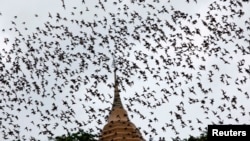Scientists suspect COVID-19 originally came from a bat, which may have harbored a wide range of coronaviruses. Despite the pandemic, the global trade in bat products continues, including in their highly prized feces, called guano.
Bat guano is commonly used throughout the world as a fertilizer, but it is also used as medicine. It can be found on Amazon, the biggest U.S. online shopping site, where the Grocery & Gourmet Food category includes a listing for 1 gram priced at $2.95 from a traditional Chinese medicine vendor.
A reservoir of viruses
Known as Ye Ming Sha, or Night Ling Sand, bat guano is one of the most popular ingredients in traditional Chinese medicine. It is used for treating eye disorders, blood stasis and embolism.
Because bats catch flying insects at night, bat guano was traditionally seen as promoting night vision. Some healers recommend putting bat droppings directly into the eyes.
In 2005, Wuhan-based virologist Shi Zhengli, now known as China's "Bat Woman," identified dozens of deadly SARS-like coronaviruses that were found in samples of bat droppings that Shi and her team collected in caves.
One of those fecal samples contained a viral genome that is 96% identical to the coronavirus that is currently spreading across the globe.
Recently, six entirely new coronaviruses have been discovered in samples of bat manure from 464 bats by a team led by Smithsonian scientist Marc Valitutto. These viruses are also in the same family as the SARS-CoV-2, the virus that causes COVID-19, according to the research.
"Guano is dangerous because it harbors virus," Dr. Robert Siegel, a professor in the Department of Microbiology and Immunology at Stanford University, told VOA.
The exact mechanism by which the coronavirus jumped from a bat to a human is the subject of intense global research. Scientists have suggested that because the virus is found in bats' blood and saliva, transmission could have occurred from a bite. But bats don’t commonly bite humans.
"Most bats do not bite, particularly the kinds of bats associated with coronavirus outbreaks," Siegel said.
Instead, humans mostly get infected from bats merely by spending time with them, such as when workers collect bat guano from a cave, or when miners or spelunkers spend hours breathing in the same confined space as a bat colony.
"The risk from bats is greatly related to how much contact people have with bats," said Siegel.
Three years ago, Shi was called in to investigate a virus outbreak in a mine shaft where six miners suffered from pneumonia-like diseases that killed two of them.
“Bat guano covered in fungus littered the cave,” Shi told Scientific American in a report published last month. She said it would have been only a matter of time before the miners became sick.
Another scientific report from Thailand in 2013 found coronaviruses in about 4% of collected bat guano samples, leading the researchers to recommend workers use better personal protection when harvesting the guano in caves.
A dangerous trade
Wuhan’s so-called “wet market” that sold live animals remains the suspected original outbreak site of the COVID-19 pandemic.
But German scientist Trudy Wassenaar, who studied the outbreak, suspects the first transmission occurred through bat feces, not bat meat.
In late January, when the genomes of coronavirus were first made public by Chinese researchers, Wassenaar took a closer look at the sequences, trying to determine where the outbreak originated.
One of the questions she asked herself was "how this virus could have reached humans, as it is clearly a bat virus," Wassenaar said. The question led her and co-author Zou Ying, a Wuhan-based colleague, to write a research paper in February that argued that people more often come into close contact with live bats not for food, but for traditional Chinese medicine.
"The key to this question is money," she told VOA, because the market for Chinese medicinal products involving bat guano is much bigger than the market for its meat. And that puts the workers who gather the raw materials at high risk.
"Bats are still captured to sell their body parts, which provides a possibility for their viruses to jump to humans, either directly or via an intermediate mammalian host," she said.
China downplays guano risks
There is no evidence that medicines made from bat guano can transmit the coronavirus. In 2005, when Chinese researchers were grappling with the SARS outbreak from another coronavirus, one of the country’s top respiratory experts, Zhong Nanshan, downplayed the risk from bat guano. He said because the guano is usually steamed, boiled or fried before going into the medicine, even if there is a virus present, it would be killed within a few minutes.
"Don't worry about taking Ye Ming Sha," Zhong said, according to a news report published in The Information Times, a paper published under the official Guangzhou Daily.
Other supporters of the sale of Ye Ming Sha also argued that it is first dried and unlikely to contain infectious virus by the time it reaches customers.
To some scientists, the end product is not the only, or even the main, risk.
They believe that as long as bat guano is being sold, people will continue to go into caves to collect it and risk becoming infected by another bat coronavirus.











